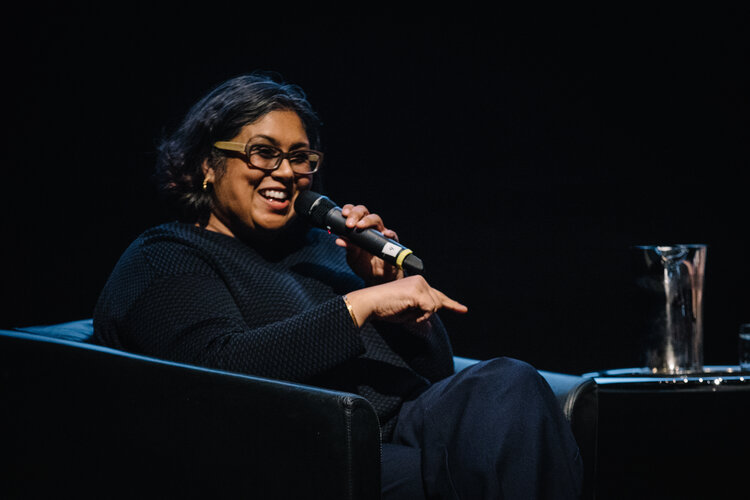Artist and activist Caroline Woolard will be the William Wilson Corcoran Visiting Professor of Community Engagement this year. She will teach a course called “The Art Worlds We Want,” a combination of studio course and seminar, open to students across disciplines, which will meet Thursday evenings in a gallery space in the Flagg Building. The Corcoran School of the Arts and Design is housed in GW’s Columbian College of Arts and Sciences.
The course reflects Woolard’s interest in collaborating on projects designed to bring a better, more just society into being. It will explore the ways that creative projects might be allowed to move through the world “with principles of cooperation and care,” she said.
The William Wilson Corcoran Visiting Professor position is funded by a grant administered by the Trustees of the Corcoran Gallery of Art and is intended for individuals with publicly engaged art practice. The visiting professor connects with the D.C. community and enables the Corcoran to drive social change at the local level.
“We are very excited to welcome Caroline Woolard to the Corcoran this year,” said Lauren Onkey, the school’s director. “I’m certain that she will have a galvanizing impact on our community—her commitment to collaboration, sustainability and justice will challenge us all to do our best work. Since 2016, the Visiting Professorship of Community Engagement has been one of our most successful initiatives, and we are grateful for the support of the Corcoran Gallery Board for this position.”
Woolard has been called a conceptual artist, but it’s hard to describe her work in a word, unless that word is unique. She designs experiences and sometimes sculpts physical objects; her work often has a strong digital component.
“My life's work is to co-create experiences of cooperation,” Woolard has said. Her work shows her pronounced interest in solidarity economies.
She co-created Trade School, an international barter-based network that, over the 10 years of its existence, brought more than 22,000 people to various classes in exchange for items requested by the teacher.
One of the Trade School courses, about economics for artists, was taught by an instructor who asked for things like recipes and food. Woolard taught a course in grant writing in exchange for help moving materials she used in her sculpture projects.
“People asked for all kinds of things,” Woolard said. “Sometimes child care, sometimes extra materials like fabric or supplies. In a way, it felt like a potluck for the teacher, like mutual aid or a gift system. People are always wanting it to come back to life, which it could.”
With her Trade School collaborators, Woolard designed and built experimental furniture using materials such as five-gallon buckets. One of her solo projects, “Queer Rocker,” is an unusual chair that can be inexpensively reproduced.
“Part of my work is around creating environments that allow people to imagine the worlds that they want,” Woolard said. “I believe that very unconventional furniture and physically moving your body in ways that you might not be accustomed to—for example, with this rocker—helps people get in a state that allows them to dream and imagine new ways of being.”
As a self-described “queer artist,” Woolard said, she is especially pleased with her Queer Rocker “because it uses craft techniques that I love and because it raises the question, what makes something queer? The writer Sara Ahmed describes what it is to be queer as fundamentally misrecognizing the function of things. It’s an orientation that has to do with desire, absolutely, but also with building worlds anew. This object tries to speak to that.”
The "Queer Rocker" was created using a CNC machine to cut out all of the shapes needed for the chair from one sheet of plywood, making it an efficient use of material. Woolard gives the file to anyone who requests it, and students around the world have adapted it for their own use.
“This work exemplifies the principles that most interest me in practice, like being more sustainable in the way that we use materials, addressing multiple identities, ways of imagining the use of space and what it means to be queer, and also of economic accessibility,” Woolard said. “I want a file that can be shared and adapted and a kind of free software.”
Woolard’s rocker departs from art’s customary material regime in which a single object has value by virtue of the maker’s authority. Instead, she encourages others to reproduce the same object.
“For me,” she said, “the ultimate honor is someone wanting to adapt and work with an idea or form that I present to them. And this acknowledges that whatever ideas or forms I create also come from a lineage and a world of existing material. It's not springing from nowhere.”
Her “DIY Ruin” project proposes a new way of looking at ruined classical columns, which have been removed from their countries of origin and displayed in imperial settings.
“Often, if you look at ruins of columns, you'll see that they've been disassembled into segments and taken away,” Woolard said. “This project imagines a future where the heritage of empire is dismantled. On the pathway of shifting our collective fantasy about what worlds we want to live in, we need to take apart the columns and use them differently, maybe first as seats, and then eventually another aesthetic can emerge.”
Woolard’s concerns with social and economic justice grow organically out of her own background. Her father, she said, did not want her to become an artist for fear she would not be able to live well.
“He grew up poor, on a tobacco farm without running water,” Woolard said. “He never wanted me to choose a path that he imagined would be one of poverty. From a young age, I loved working with creativity and culture, making things. And I also knew that this is not valued by my father and by society at large, especially in the United States.”
Even artists who look extremely wealthy, she said, “often have given themselves a larger hamster wheel of expenses to run on. It’s not always the case that they are taking home more money. And it's also not always the case that they receive the money that you hear about in the news. So, for example, if a painting sells at Sotheby’s for $5 million, that is not money that the artist ever sees. That's important for people to know.”
Happily, her father “has come around,” she said. “He does see me as successful and happy. I remember him saying to me, ‘How are you going to support me when I'm old?’ It was very painful for me to hear. And I couldn't put it in words at the time, but now I can say, ‘You’ll have a daughter who is conscious of her own agency and able to manifest things in the world.’ If I had gone into a more—in his eyes—legitimate field, I might not feel so fulfilled and be able to show up for him in the way that I can now, because I'm able to do what I really love.”





